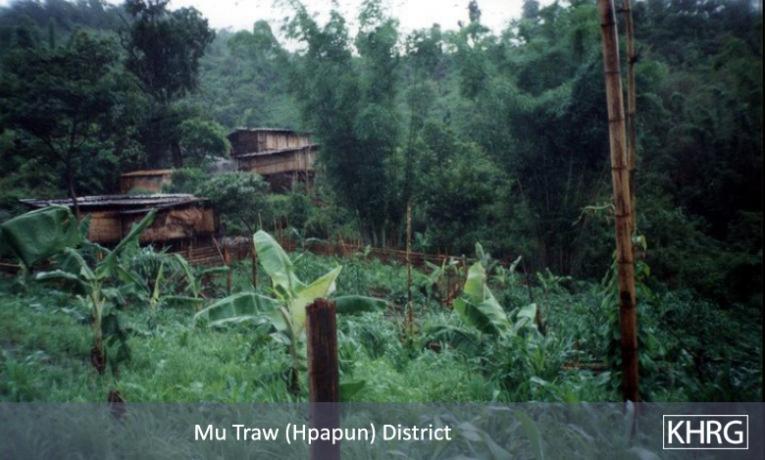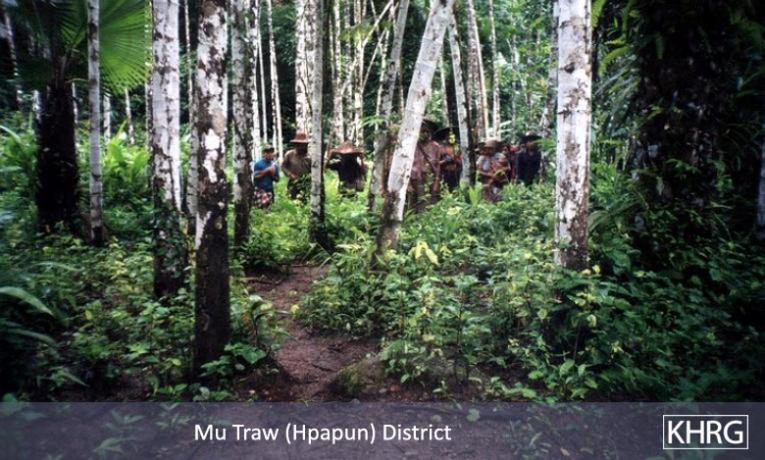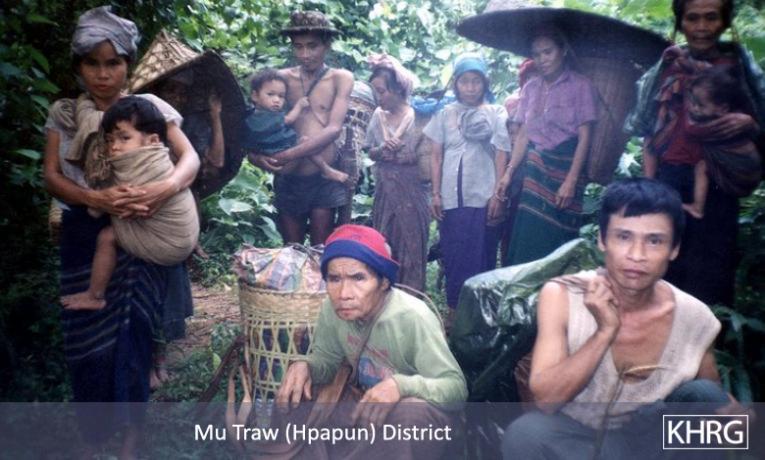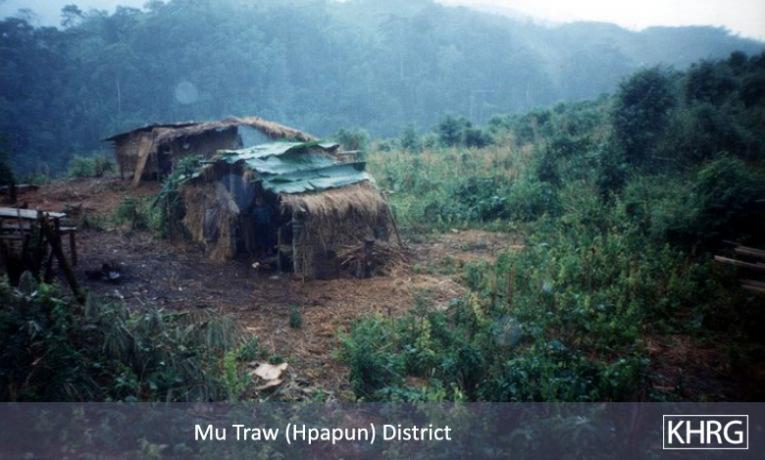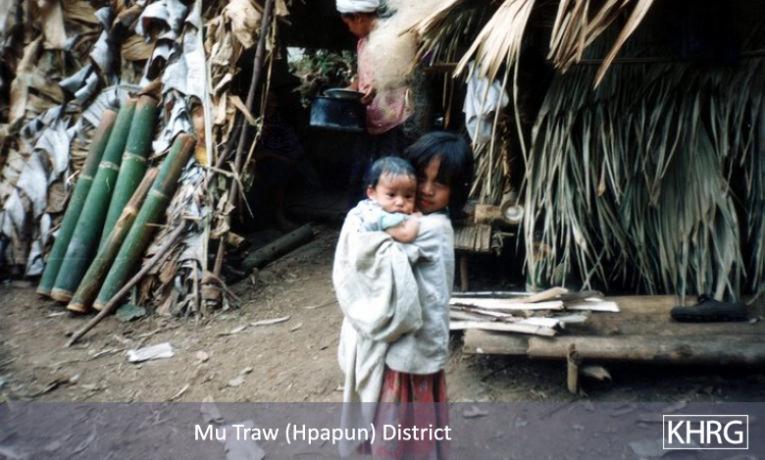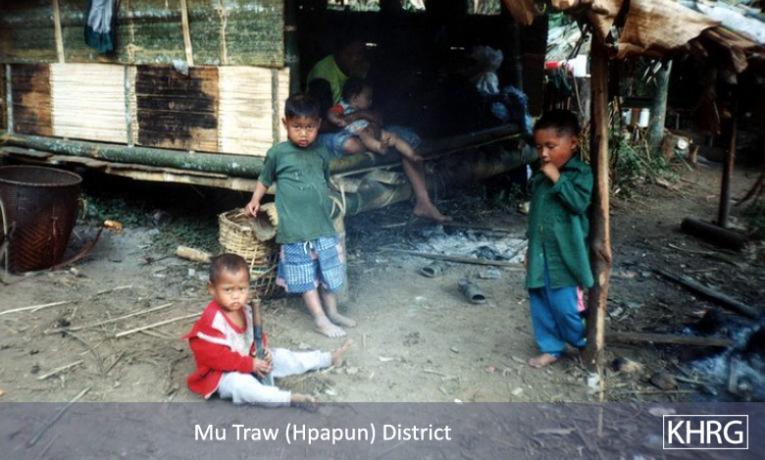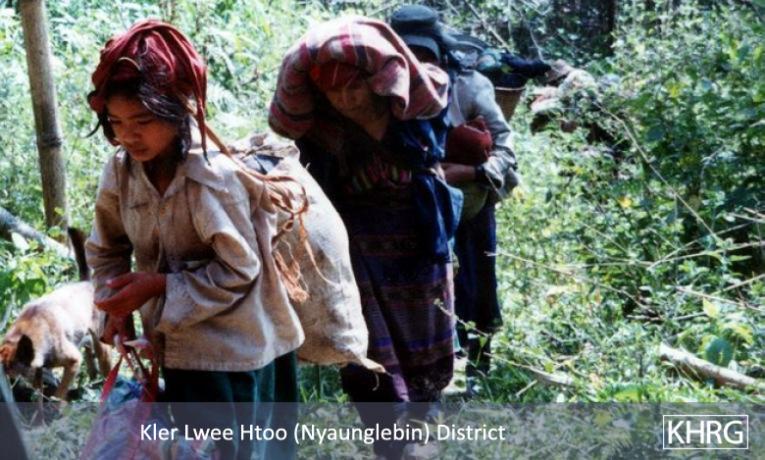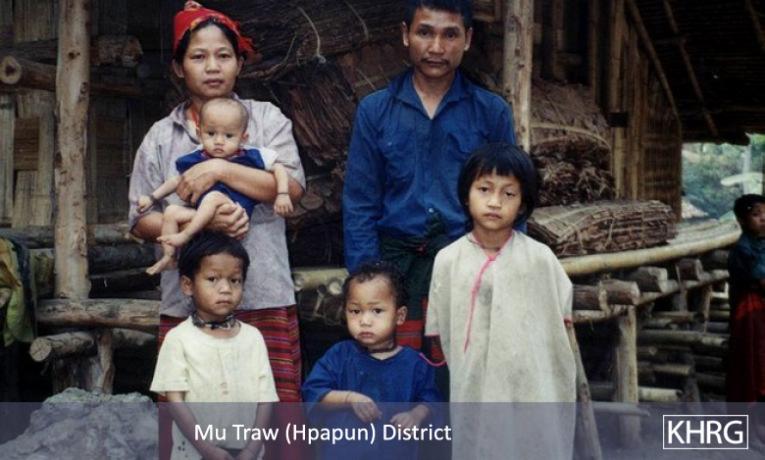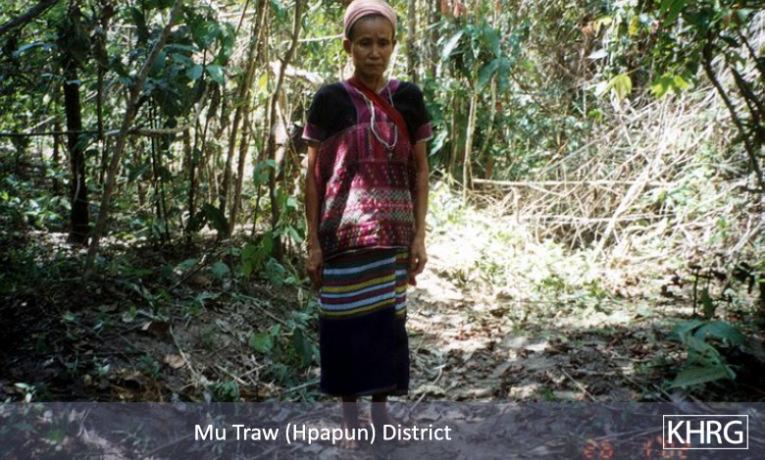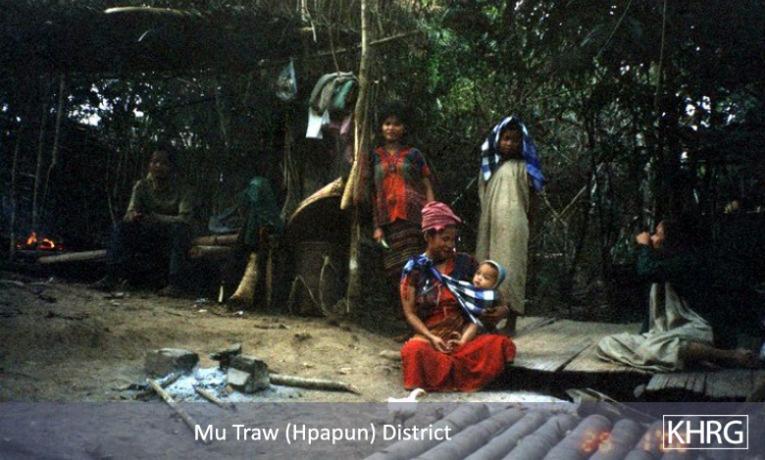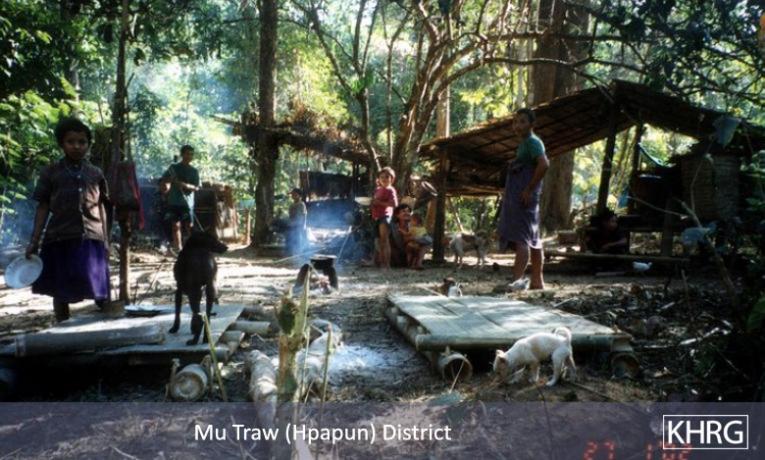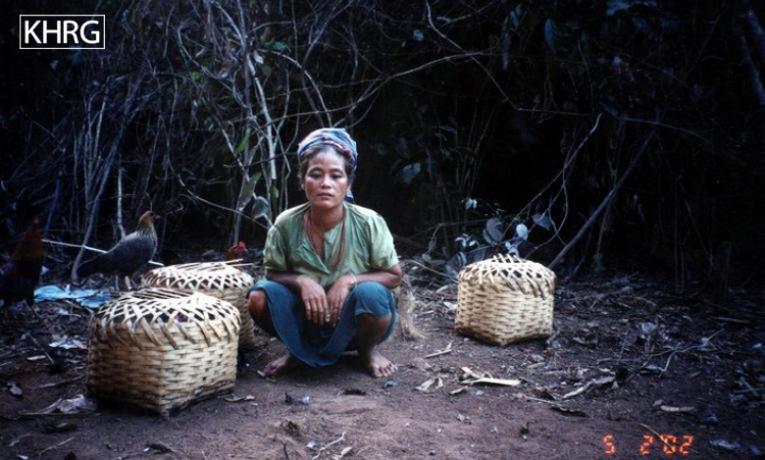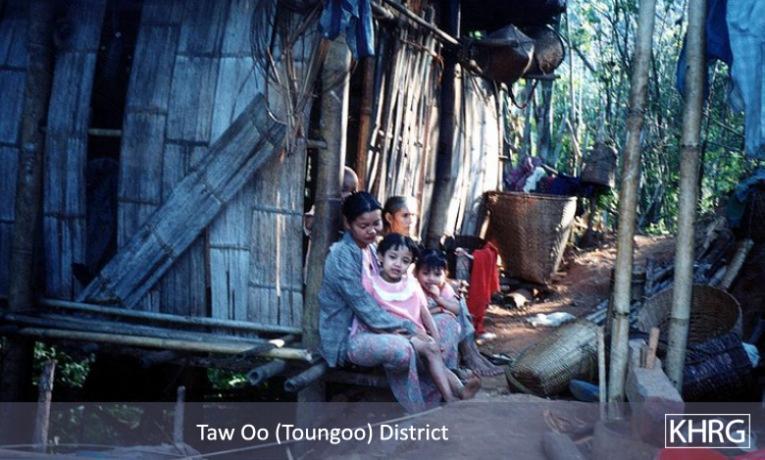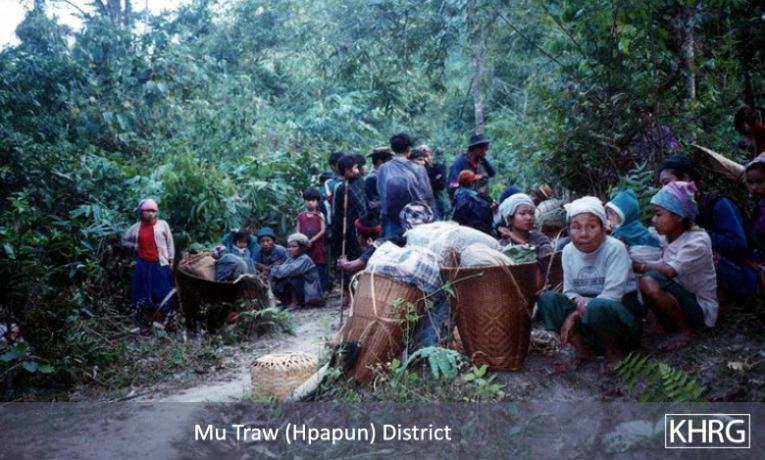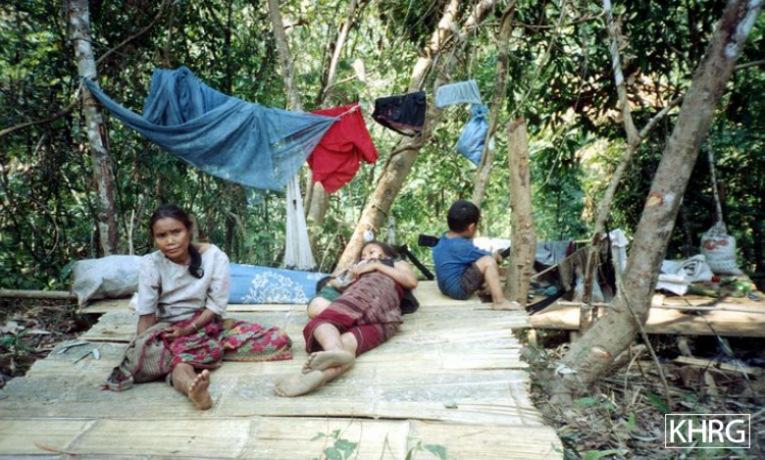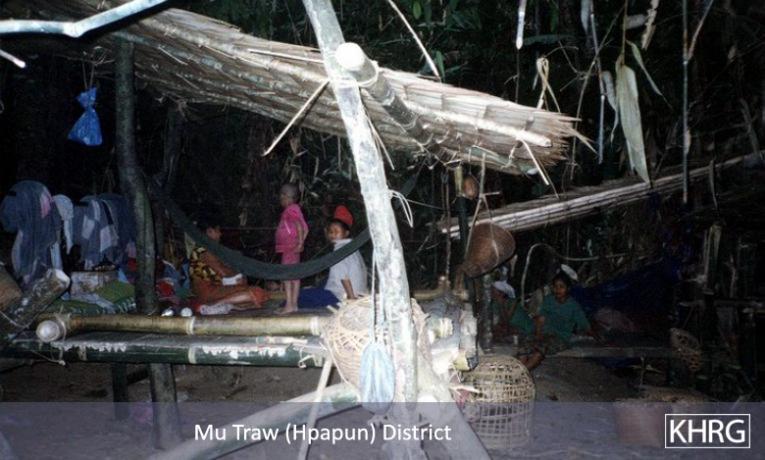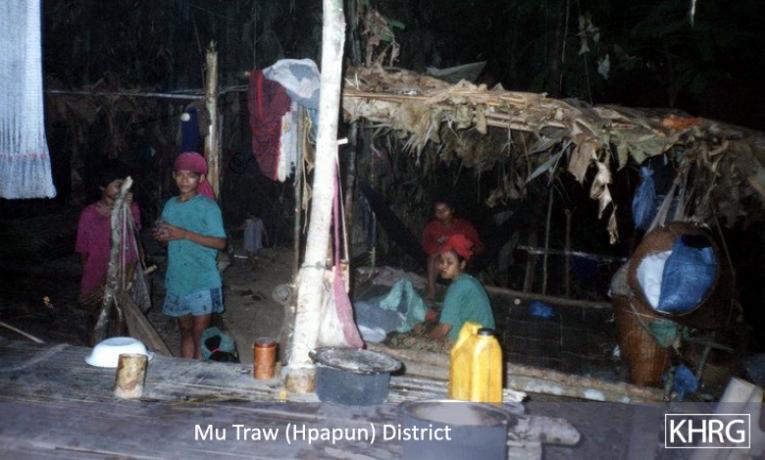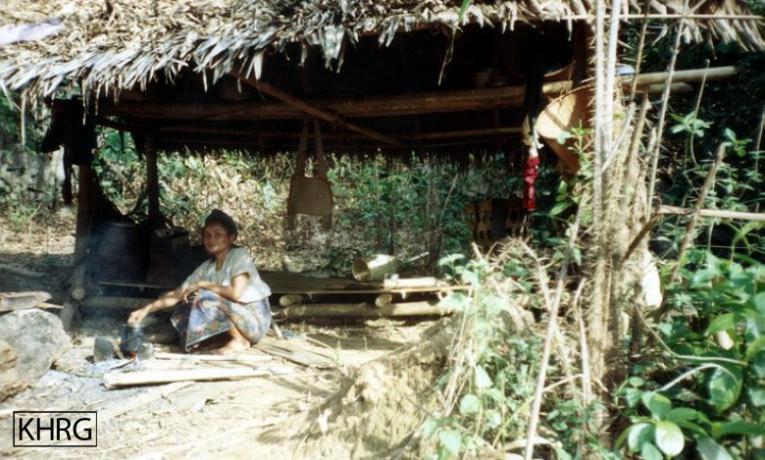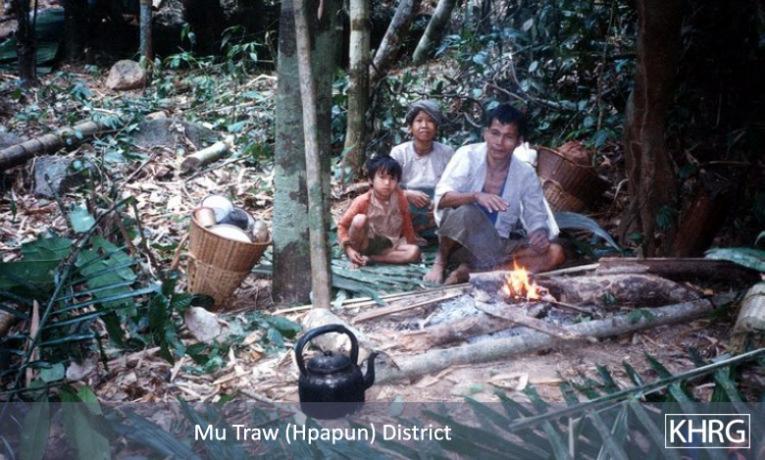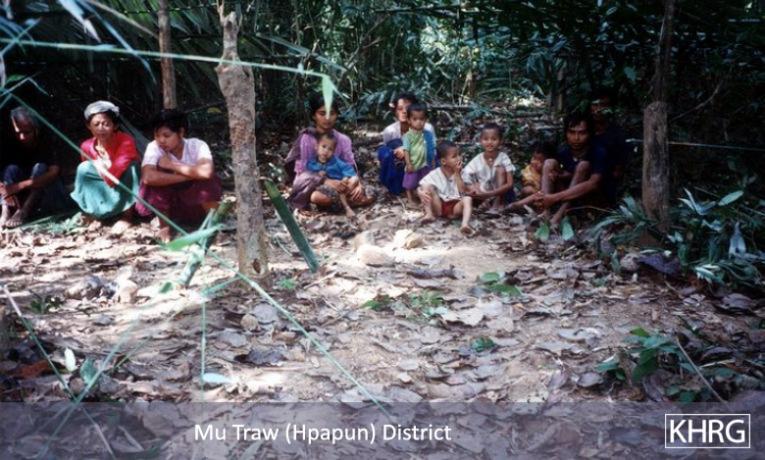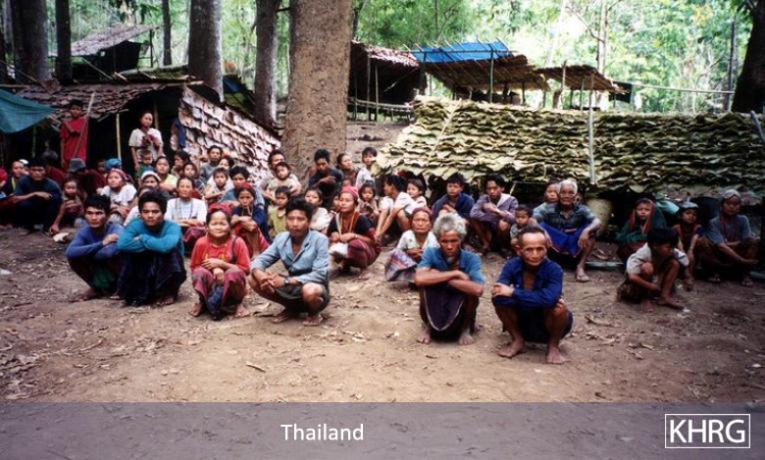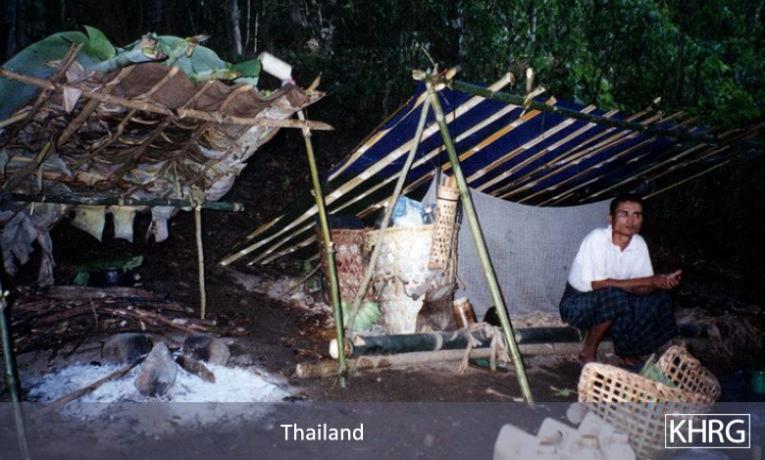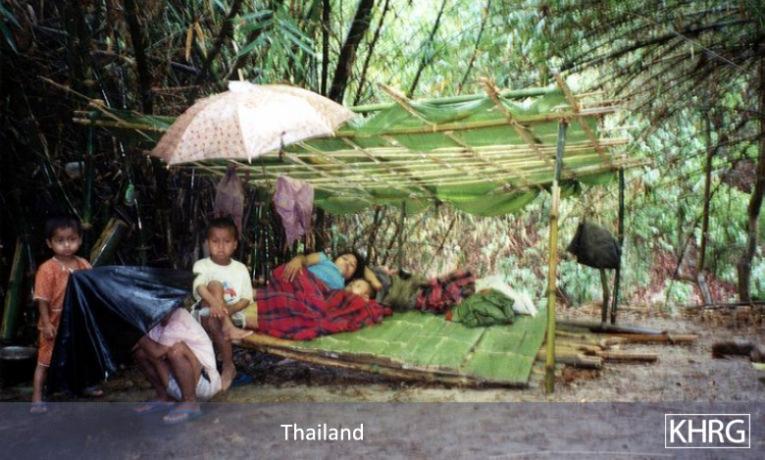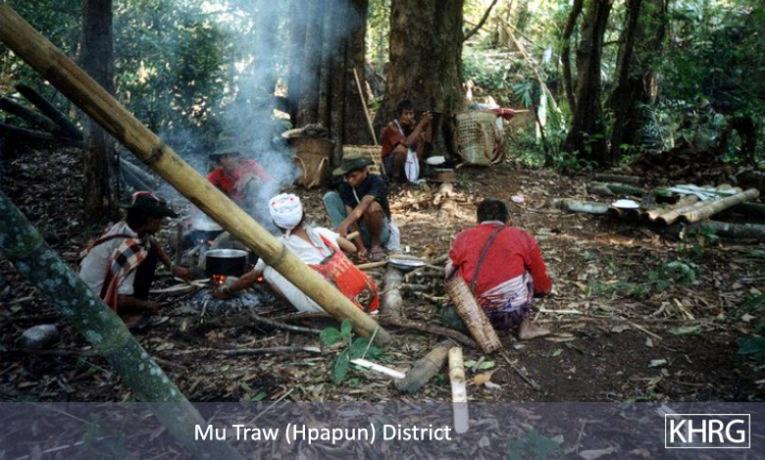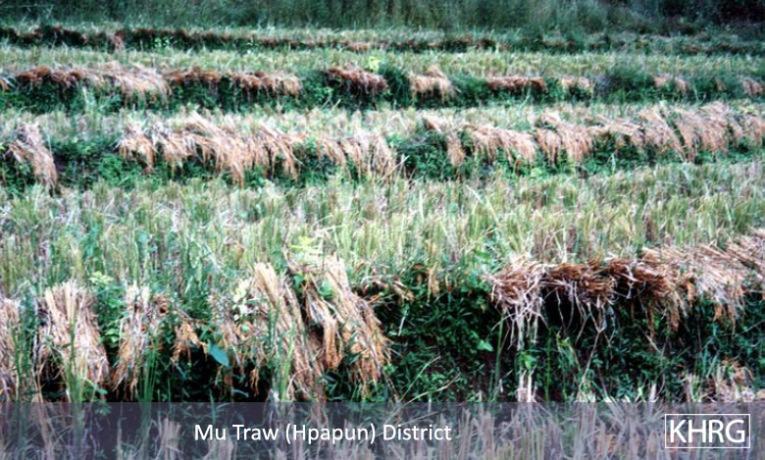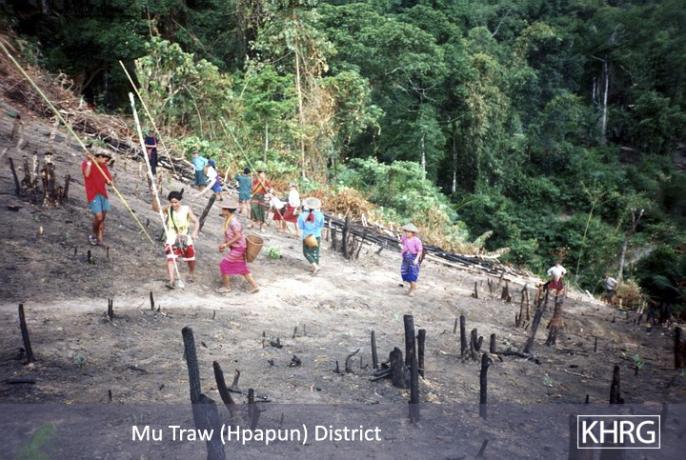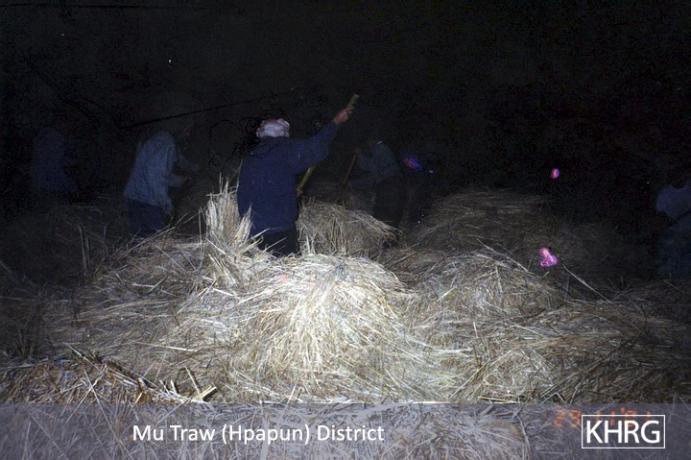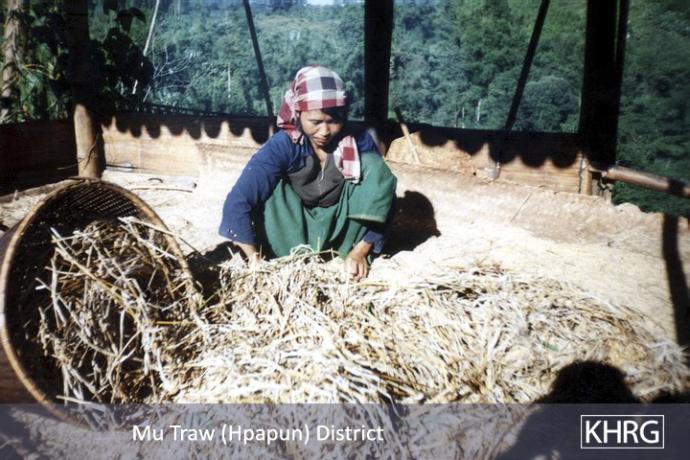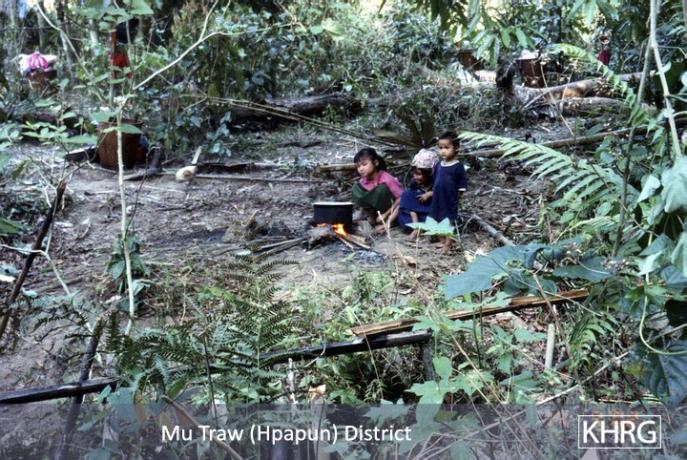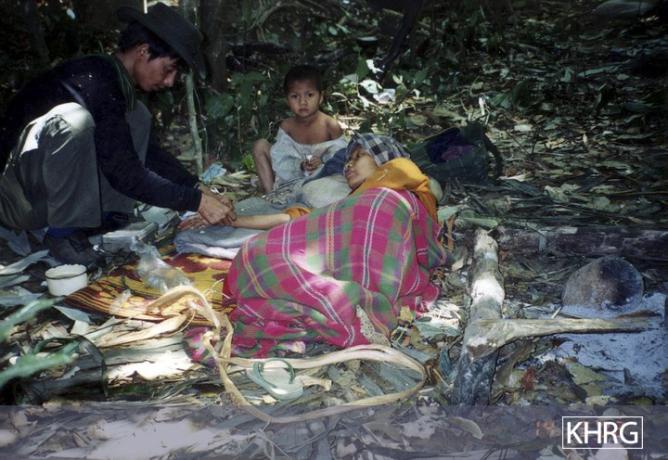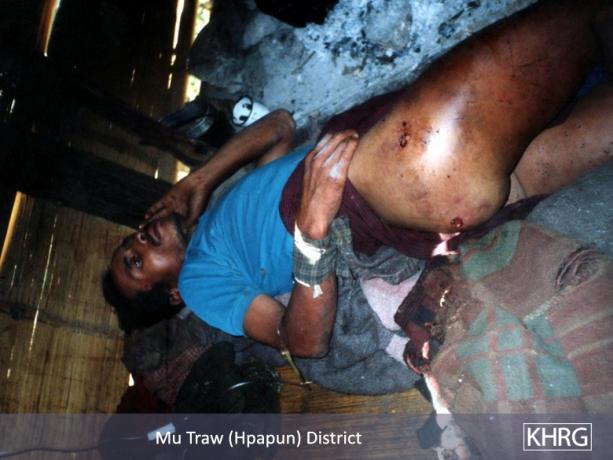These photos were taken and collected by KHRG since the publication of Photo Set 2001-A in September 2001. The photos in this set were taken in Toungoo, Nyaunglebin, Papun, Thaton, Pa’an and Dooplaya Districts. The photos have been divided into separate headings: ‘Forced Labour’, 'Attacks on Villages & Village Destruction', 'Detention and Torture', 'Shootings and Killings', 'Flight and Displacement', 'Landmines', 'Soldiers', 'Children', and 'Food'. Brief descriptions of the topics covered under each heading are provided at the beginning of each section.
This photo set contains more than 500 photos and their descriptions which document the human rights situation in Karen areas of Burma. These photos were taken and collected by KHRG since the publication of Photo Set 2001-A in September 2001. The photos in this set were taken in Toungoo, Nyaunglebin, Papun, Thaton, Pa’an and Dooplaya Districts. The photos have been divided into separate headings: ‘Forced Labour’, 'Attacks on Villages & Village Destruction', 'Detention and Torture', 'Shootings and Killings', 'Flight and Displacement', 'Landmines', 'Soldiers', 'Children', and 'Food'. Brief descriptions of the topics covered under each heading are provided at the beginning of each section. More detailed information on the abuses and the regions is available in KHRG documentary reports, several of which are referenced in the text below. Of important note is that many of the abuses documented in this photo set occurred after Aung San Suu Kyi was released from house arrest in May 2002 and international attention increasingly began to focus on an imminent agreement between the SPDC and the National League for Democracy. These photos graphically demonstrate that while the international community discusses the ‘progress’ in Rangoon, gross human rights abuses continue to be committed by SPDC forces in the countryside. The numerous forced labour photos in this set have been taken since the SPDC claimed that it had put an end to forced labour, most of them since the International Labour Organisation’s High Level Team released its report criticising the regime's continued use of forced labour and its inadequate attempts to halt the practice.
Almost all of the images in this photo set were taken by KHRG human rights researchers in the field, as noted in the photo captions. Photos taken by other researchers are credited to those who provided them. The photos contained in the set have been chosen as a sampling, and are intended to show as many aspects of the situation as possible. Details of some of the people and places have been deliberately omitted from the photo descriptions or replaced by ‘xxxx’, ‘yyyy’, ‘aaaa’, ‘bbbb’, etc. where necessary to protect the villagers involved. Some of the faces have also been blocked out for the same reasons. While looking at the photos, please remember that they were taken under difficult and often dangerous circumstances with low budget equipment, and quality is as incoming.
The photos are not numbered sequentially, but according to the main section in which they appear; for example, photos related primarily to Forced Labour are numbered A1, A2, etc., and those related to Attacks on Villages and Village Destruction are numbered B1, B2, etc. Photos which are relevant to more than one section are displayed more than once. For example, a photo of children doing forced labour will appear in both the Forced Labour section and the Children section, but will bear the same number in both places; as a result, the sequence of numbered photos may appear something like A1, A2, C47, A3, A4, D12, D13, A5, etc.
Copies of the photo prints or digital copies scanned at higher resolution can be obtained upon approval from KHRG, by specifying the photo set and photo numbers and paying the costs involved. Organisations may download the images from the KHRG web site or use the prints for publication on a not-for-profit basis, provided they are properly credited; any publication for commercial purposes requires permission of the copyright holders. This can be obtained by contacting KHRG.
This photo set attempts to give a visual impression of the situation in many different areas, and is intended for use together with KHRG's more detailed regional reports. For a more comprehensive picture of the human rights situation in each area, see the reports referenced in the summaries and photo captions below.
V. Flight and Displacement
Villagers are fleeing SPDC-controlled villages, relocation sites and villages destroyed by the SPDC in increasing numbers because of the deteriorating conditions described in the other sections of this report. Most villagers only leave their villages when they have no other option. Subsistence farmers with strong ties to the land, Karen villagers find it almost unbearable to be far from their land. They usually begin by fleeing into the surrounding forests or their field huts. When SPDC patrols hunting them get too close they flee farther into the forest but usually within reach of their fields so that they can still work them. They try to plant rice in small parts of their fields, usually spread out to avoid detection. Until the crops are harvestable the villages make secret trips back to rice storage barns hidden in the forest to get rice and seed grain. To supplement their diet they forage for vegetables and roots in the forest. Some villagers are able take some of their chickens with them when they flee, but pigs and cattle are rare. Most villagers must flee with with their children and whatever they have on their backs. After fleeing like this several times there is little opportunity, or incentive, to raise chickens or livestock which are expensive and must usually be left behind.
Internally displaced villagers live in small groups of a few families so that the chance of detection is reduced. They must always be ready to flee again so they listen for the news of the movements of SPDC columns from other displaced villagers and KNLA units. Whenever SPDC columns come near they must flee again farther into the hills. Despite these precautions, villagers are still caught in their fields or on paths and shot on sight (see the photos in the "Shootings and Killings" section). The villagers also must fear the landmines which are laid by all sides. The SPDC deliberately mines the paths, fields and abandoned villages of displaced villagers to make it impossible for them to live in the area. KNLA units lay landmines to restrict the movements of SPDC columns, and DKBA units do the same against the KNLA. Many of the victims of the landmines laid by the SPDC, DKBA and KNLA are villagers, especially the internally displaced, who often bleed to death before they can be carried to medical help (see the photos in the "Landmines" section).
Although the risks are high, most villagers would prefer to remain near their fields, or at least on some land where they may be able to grow a crop, rather than fleeing across the border into Thailand. The internally displaced villagers would rather hold on to the hope of one day being able to go home and live in their own villages. The smaller number that do make the long and dangerous trip to Thailand usually only do so after all hope of growing a crop or having enough food to survive until they can grow a crop has completely gone. Several hundred thousand villagers live a very precarious existence in Karen State alone. Much of the population in the mountains of Toungoo District in the north chooses to live in hiding in the forest rather than live in the SPDC-controlled 'peace villages' or relocation sites. where they must serve as forced labour for the SPDC's spreading road network and as porters (see "Peace Villages and Hiding VIllages", KHRG #2000-05, 15/10/00). Slightly further south, the SPDC has systematically destroyed more than 200 villages since 1997 in the hills of Nyaunglebin and northern Papun districts. This has forced more than 50,000 people to flee into the forests where they still remain in hiding (see "Flight, Hunger and Survival", KHRG #2001-03, 22/10/01).
In Dooplaya District of southern Karen State, SPDC battalions began in February 2002 a campaign of village relocations and destructions which is still ongoing. When the relocation orders were received many villagers opted to flee into the forest or to Thailand. Some villagers who did not go to the relocation sites by the specified deadlines have been shot on sight. In one case in late April, Infantry Battalion #78 discovered a group of villagers attempting to flee to Thailand and massacred ten of them, leaving nine others wounded. Six of the ten dead were children; eight were women and girls. (see Photos #D4-D7 and KHRG Information Update #2002-U5, 25/9/02).
The photos in the sections below come from Toungoo, Nyaunglebin, Papun, Thaton, Pa'an, and Dooplaya Districts. Many of the photos come from Nyaunglebin and Papun Districts where the most extensive displacement is currently taking place. The photos are divided into 4 subsections: Life on the Run, Food, Health, and Education. Life on the Run illustrates the flight of people from their villages to escape the SPDC columns and their struggle to survive in hiding in the forests. Food documents the struggle of the internally displaced to get enough food to survive. Health shows the almost complete lack of health care and the struggle to survive with only traditional medicines. Education documents the loss of access to education due to displacement and the efforts of the villagers to continue teaching their children even while they are on the run in the forest.
1) Life on the Run
2) Food
The photos below also show some of the struggles the internally displaced villagers must face in getting enough food to survive. Their struggle is made all the more difficult by the SPDC's operations to destroy their crops and their food caches. The lives of internally displaced villagers are constantly at risk whether they are planting a small crop in a hill field, hiking to an SPDC-controlled village to buy rice to carry back into the hills, or retrieving a basket of rice from a hidden rice storage barn. Depending on their luck, some villagers are able to survive this way for months or years, but eventually most of them find themselves driven into starvation and they have little choice but to flee to another area or head toward the border with Thailand. In the captions below, paddy is the term used to refer to rice off the stalk which has not yet been husked. Villagers dry the paddy and store it in paddy barns before pounding small amounts of it to husk it in preparation for cooking.
3) Health
The photos below also show some of the difficulties the internally displaced must face protecting themselves from illness and seeking medical attention in a situation where there is an almost complete lack of modern medicines or outside medical help. The SPDC prohibits the transport of any medicines into the mountains on the grounds that the medicines 'could end up with the resistance.' There have been many cases of traders and villagers who have been executed after being caught trying to carry medicines into the hills. While many villagers have been killed by the SPDC's soldiers, many more are dying from treatable illness such as malaria, dysentery, diarrhoea and infections. This is especially so among the children and the elderly. For additional photos related to the difficulty of obtaining medical treatment for villagers who have been shot, tortured or have stepped on landmines, see also the "Shootings and Killings" and "Landmines" sections.
4) Education
SPDC columns sent to destroy villages usually target the school and other community buildings first. The children of the displaced villagers lose any access to whatever education they previously had. Their parents often lament this fact when speaking to KHRG researchers in the field. The value that these people place on education becomes very clear when you come upon a group of villagers in the forest, living on the ground in lean-to shelters of leaves with almost nothing to eat and on the run from SPDC troops, yet with a rudimentary blackboard set up between the trees and one of the villagers teaching the children to read and write.
Photo #E1: Naw A--- (31 years old) from K--- village, northern Papun District and her five children. She told KHRG researchers that she has been unable to live in her village since 1997 because the SPDC soldiers shoot at them whenever they see them. This photo was taken when she was still living in hiding in the jungle before fleeing to a refugee camp in Thailand in 2001. [Photo: KHRG researcher]
Photo #E2: Naw T---, 45 years old, from H--- village, Lu Thaw township, Papun District and her children. The villagers from her village have found it difficult to find enough food to eat because they have had to constantly flee the SPDC Army since 1996. She told KHRG that, “They [SPDC soldiers] don’t only kill the old people and children, they kill everyone. They don’t only oppress H--- village, they oppress all the villages around H--- village. The Burmese don’t only shoot the people holding weapons [KNLA], they treat us the same as the people who hold weapons. They also said we are the strength of the people who hold weapons, so they will destroy all of our Karen people so there won’t be anyone alive anymore.” She could no longer endure the constant hunger and fear of living in the forest, so she started the difficult journey to a refugee camp in mid-2001. [Photo: KHRG researcher]
Photo #E3: Saw W---, 50 years old, is the village head of xxxx hiding site, Papun District. He and his villagers fled to an internally displaced villager hiding site after SPDC soldiers burned their village. According to him, the oppression is especially bad in this area because the SPDC says it is the place where the relatives of Bo Mya, the former president of the KNU and current commander of the KNLA, live. Many of the villagers in the area are running out of food and have been forced to eat boiled rice porridge to get through the year. He said that many people had died, most of them children. [Photo: KHRG researcher]
Photos #E4, E5: Xxxx (Photo #E4) and yyyy (Photo #E5) internally displaced villager hiding sites in northern Papun District. Villagers from several villages in northern Papun District fled to these sites after SPDC soldiers burned their homes. [Photos: KHRG researcher]
Photo #E6: Saw P---, 56 years old, from Ler Mu Plaw village tract in northern Papun District. He was a hill field farmer in B--- village but he can no longer stay there since the SPDC Army set up a camp in his village. He told KHRG researchers that he has had to face a lack of food and illnesses. Sometimes he must eat bamboo shoots and roots because there is nothing else to eat. [Photo: KHRG researcher]
Photos #E7, E8: The hiding sites of xxxx (Photo #E7) and yyyy (Photo #E8) villages in northern Papun District. The villagers fled to these places after their original villages were burned down by SPDC soldiers. [Photos: KHRG researcher]
Photo #E9: Naw H---, 26 years old, used to live in M--- village, central Nyaunglebin District. On October 11th 2000, SPDC soldiers beat to death her husband, Saw P---, 30 years old, along with two other men, M--- and M---, at K--- village. She found out about it from other porters who escaped and came back to tell her. At about the same time, other SPDC soldiers came to xxxx where the M--- villagers were hiding and fired mortar shells into it. Two women, Naw D--- and Naw K---, were injured by the shrapnel. Naw H--- could no longer bear the situation and decided to flee with her one child to one of the refugee camps in Thailand. This photo was taken along the way. [Photo: KHRG researcher]
Photos #E10, E11: These two women, Naw L--- (50 years old) and Naw H---, fled from W--- village in Papun District when SPDC soldiers opened fire on the village. Naw L--- became lost in the forest and was not found until three days later. [Photo: KHRG researcher]
Photos #E12, E13, E14: Villagers from K--- village in Papun District fleeing their village after receiving word that SPDC soldiers were coming their way in late 2001. Photos #E13 and #E14 where taken on a path in the forest after fleeing the village. [Photos: KHRG researcher]
Photo #E15: N--- villagers resting on the path after fleeing their village in Papun District in August 2001. [Photo: KHRG researcher]
Photo #E16: Saw K---, 25 years old, from K--- village, Papun District. On August 3rd 2001, SPDC soldiers from LIB #xx under Battalion Commander H--- opened fire on and then entered K--- village. The 80 people living in the village where forced to flee into the forest. Saw K--- had to carry his children and was unable to take any of his food. He was forced to drop all of the pots and clothing that he was carrying when they had to cross a river. He now has nothing left and has to borrow pots from his friends when he wants to cook. [Photo: KHRG researcher]
Photo #E17: Villagers from K--- village resting in the forest after fleeing units of the SPDC Army in Papun District in August 2001. [Photo: KHRG researcher]
Photos #E18, E19: Internally displaced villagers who recently fled their villages to the xxxx area in Papun District. Note the number of small children and elderly among the villagers. Both the children and elderly are more easily susceptible to diseases and life on the run in the forest is very difficult for them. [Photos: KHRG researcher]
Photo #E20: Villagers from M--- village, eastern Papun District who have fled up into the mountains after SPDC soldiers destroyed their village. [Photo: KHRG researcher]
Photo #E21: Saw Y---, 28 year old hill field farmer from P--- village, northern Papun District. He has had to live in hiding in the forest since his village was burned by SPDC soldiers in 1996. He told a KHRG researcher that the soldiers have not come to the area where the villagers have been hiding, but the operations of the SPDC columns have been getting closer since the beginning of November 2001, so the villagers have had to worry about the soldiers again. [Photo: KHRG researcher]
Photo #E22: Villagers fleeing SPDC soldiers take a rest beside the xxxx River before continuing their flight. This photo was taken in northern Papun District in December 2001. [Photo: KHRG researcher]
Photo #E23: Villagers from H--- village, northern Papun District who were staying temporarily at xxxx village after fleeing SPDC soldiers in early December 2001. [Photo: KHRG researcher]
Photo #E24: T--- villagers in there new hiding place in the forest after fleeing SPDC battalions in northern Papun District. [Photo: KHRG researcher]
Photo #E25: Saw L---, 62 years old, is the village head of xxxx village, northern Papun District. He told KHRG researchers how on December 2nd 2001 SPDC soldiers from LIB #503 and IB #7 came to xxxx village and opened fire. Another villager, Saw P---, was injured in the left shoulder. Most of the villagers were able to take their belongings and run away, but the soldiers captured Naw P---, 50 years old, and took her with them for four hours. They then forced her to sit down, touched her with a gun and asked, “Do you want to die?” She told them, “If you want to kill me don’t torture me, just kill me immediately. I am already old. In my life I have only worked a hill field, but now I can’t work to get food anymore.” The soldiers then released her. [Photo: KHRG researcher]
Photos #E26, E27: Villagers from L--- village, Papun District rest in a dry riverbed after fleeing an SPDC column. The soldiers of Tactical Operations Command #333 of LID #33 entered L--- village on November 25th 2001 causing the villagers to flee. The soldiers stayed in the village for several days looting the villagers' livestock and possessions and then burned and destroyed what remained. The presence of SPDC soldiers in L--- village caused the villagers in surrounding villages to flee into the forest in case the column came to their villages as well. Most of the villagers were unable to take blankets and clothes with them when they fled. November is the beginning of the cold season, when night temperatures can drop close to freezing in these hills, but the villagers are unable to light fires out of fear of the nearby SPDC troops. Some of the villagers have become sick and have coughs and fevers because of the cold. The cold is especially bad for the children and the elderly. [Photos: KHRG researcher]
Photo #E28: Internally displaced children in the forest. Children like these have few opportunities for play and must often grow up early while helping their parents to survive in the forest. [Photo: KHRG researcher]
Photo #E29: Saw P---, 56 years old, is a hill field farmer from M--- village in Papun District. He had to flee along with the other villagers from his village when SPDC soldiers of LID #33 entered T--- village which was only a half hour away. They had to leave their hill fields behind when they fled and now must face difficulty in finding enough food to eat. [Photo: KHRG researcher]
Photo #E30: Platforms which the M--- villagers in Papun District have made to live on in the forest. The nearby presence of SPDC troops has made it too dangerous for them to stay in their village anymore so they have run to stay in the forest. Most of their belongings and food were lost when they fled. [Photo: KHRG researcher]
Photo #E31: Villagers from M--- village tract in western Papun District in their makeshift shelter after fleeing SPDC soldiers in late 2001. [Photo: KHRG researcher]
Photo #E32: M---, a 71 year old hill field farmer. He used to stay in K--- in Nyaunglebin District but because of the operations of the SPDC Army he has been forced to flee several times since November 2000, eventually arriving at the internally displaced villager hiding site where this photo was taken. [Photo: KHRG researcher]
Photo #E33: Saw P--- is a 38 year old married hill field farmer and village head from xxxx village, Papun District. On November 14th 2001, LIB's #xx and xxx came to yyyy where the xxxx villagers were hiding, forcing the villagers to flee. The soldiers ate the villagers’ pigs, chickens and goats, dismantled the villagers’ houses and took many of the villagers’ belongings. [Photo: KHRG researcher]
Photos #E34, E35: Thatch and leaf huts that the T--- villagers have built for themselves in their new hiding place after fleeing their village when SPDC soldiers entered the area in late 2001. T--- village is in Papun District [Photos: KHRG researcher]
Photos #E36, E37, E38, E39: Villager children from Nyaunglebin District who fled with their families into western Papun District in late 2001. They came to Papun District after avoiding SPDC Army units that had entered their area to hunt down any villagers remaining in hiding in the forest. These photos were taken at the temporary hiding site they have built near xxxx village. [Photos: KHRG researcher]
Photos #E40: Pots, plates, blankets and used clothing which have been carried in by Karen relief teams to internally displaced villagers from Nyaunglebin District who fled to western Papun District in late 2001. While this assistance helps some of the villagers, there is never enough to provide for all the displaced villagers. Many displaced villagers in more remote areas are simply too far for relief teams to reach. [Photo: KHRG researcher]
Photo #E41: P--- is a 60 year old animist hill field farmer from K--- village in Papun District. He and the seven members of his family were forced to flee when SPDC troops of IBs #xx and #xx and LIB #xxx of LID #33 came to their village on November 12th 2001. The soldiers destroyed all of their belongings. During this time the soldiers also destroyed things in H--- and P--- villages of western Papun District. [Photo: KHRG researcher]
Photo #E42: Saw P--- is a 41 year old hill field farmer and father of five children from H--- village in Papun District. SPDC troops from IB’s #x and #xxentered the area around his village and xxxx village on October 11th 2001. They shot at the xxxx village head and his son in their hill field wounding the boy with shrapnel from a rocket-propelled grenade. (see Photos #D30-35 under "Shootings and Killings"). The villagers then became afraid and ran into the forest. [Photo: KHRG researcher]
Photos #E43, E44: Villagers from T--- flee their village in Nyaunglebin District on November 12th 2001 after receiving word that a combined column of SPDC troops from IB’s #4 and 76 and LIB #111 under Captain Htun Lwin were approaching. [Photos: KHRG researcher]
Photos #E45, E46: Villagers from T--- and K- villages, Nyaunglebin District, flee into the forest after SPDC soldiers entered the area in late November 2001. [Photos: KHRG researcher]
Photo #E47: Children from P--- and Y--- villages, Papun District, during a rest stop while fleeing their villages in late November 2001. Internally displaced children often have little chance of receiving much of an education and are often malnourished as a result of constantly having to flee the SPDC Army. [Photo: KHRG researcher]
Photo #E48: Children stand in the shelter their parents have built after fleeing SPDC troops in Nyaunglebin District and coming to an internally displaced villager site in western Papun District in early 2002. Note that there is very little inside the hut and certainly no toys for the children to play with. [Photo: KHRG researcher]
Photos #E49, E50, E51: Three families from villages in Papun District who could no longer endure the hardships of living in the forest and fled to refugee camps in Thailand in early 2002. Saw T---, 47 years old, and his family from P--- village (Photo #E49). He was a hill field farmer but SPDC soldiers destroyed his food and burned his house. Saw W---, 30 years old, and his family from S--- village (Photo #E50). A hill field farmer, he was unable to stay in his village and work his fields because of the constant activities of SPDC soldiers in the area, so he took his family and came to a refugee camp. Saw G---, 35 years old, was a hill field farmer in P--- village before SPDC soldiers came up and burned his house and all his possessions (Photo #E51). His family was no longer able to stay in the village so they fled to seek refuge in Thailand. [Photos: KHRG researcher]
Photo #E52: Villagers from M--- village in western Papun District build a small hut to rest in in the M--- hill fields after fleeing SPDC troops in late 2001. [Photo: KHRG researcher]
Photo #E53: Villagers from K--- in western Papun District build a hut to rest in after fleeing SPDC soldiers. This photo was taken on November 18th 2001. The next day, November 19th 2001, they were forced to flee again to another place when SPDC troops caught up to them. [Photo: KHRG researcher]
Photos #E54, E55, E56: Villagers from M---, T---, P--- and Y--- villages in western Papun District flee approaching SPDC Army columns in late November 2001. [Photo: KHRG researcher]
Photo #E57: This village woman from D--- in eastern Papun District lost her house and belongings when SPDC soldiers of LIB #341 and IB #19 came to her village on December 20th 2001 and looted it. What the soldiers did not want they burned along with all the houses. [Photo: KHRG researcher]
Photo #E58: Saw P---, a 47 year old Karen animist hill field farmer, lived in M--- village, eastern Papun District, until December 20th 2001 when LIB #341 and IB #19 entered the village and burned down his house and rice barn with all of his belongings inside. He fled with his family into the forest and now they do not have any food and must go to ask for it in other villages. [Photo: KHRG researcher]
Photos #E59, E60, E61, E62: Villagers from B---, P---, N--- and K--- villages in eastern Papun District. Naw Y--- (Photo #E59), a 40 year old married hill field farmer, and Naw H--- (Photo #E60), a 56 year old married hill field farmer, lived in B--- and P--- villages until December 18th 2001. On that day, LIB #341 under Commander Myint Tin and IB #19 under Commander Moe Kyaw came to their villages and burned down the villagers' paddy barns and houses together with all of their belongings. The soldiers also took some of her poultry to eat and killed the rest. On December 21st the soldiers went on to burn K--- village and then N--- village on the 22nd. Villagers from K--- village told KHRG researchers that there was a primary school in the village run by the villagers. It had one teacher and 21 students, but the school was burned along with the rest of the village. [Photos: KHRG researcher]
Photo #E63: Naw K--- is a 26 year old married hill field farmer from K--- village in eastern Papun District. On December 18th 2001, LIB #341 and IB #19 drove her family and seven others to a relocation site at xxxx Army camp. The soldiers burned down all of the houses after they left. The relocated villagers were provided with no food or building materials at the relocation site, so after staying there a few days they fled into the forest. [Photo: KHRG researcher]
Photo #E64: Children from D--- village in eastern Papun District who were forced to flee with their parents when SPDC soldiers came to relocate and burn their village in late December 2001. Their parents told KHRG they would rather flee with their children into the forest than live in an SPDC relocation site, where they know that people find it difficult to provide for their children due to the heavy demands for forced labour and 'fees'. This photo was taken a month later in January 2002. [Photo: KHRG researcher]
Photo #E65: Villagers from T--- village in eastern Papun District rest on their way to the xxxx River in January 2002. They no longer stay in their village since the SPDC burned down the village and the paddy barns and destroyed all of their belongings in December 2001. They have nothing left to eat. [Photo: KHRG researcher]
Photo #E66: Naw H---, 32 years old, weaves thatch roofing for her new hut in the forest. She is a hill field farmer from K--- village in Papun District. On January 31st 2002, LIB #11 entered her village and the villagers fled in fear into the forest. [Photo: KHRG researcher]
Photos #E67, E68: Saw M--- (Photo #E67), 62 years old, is a hill field farmer from N--- village. Ma K--- (Photo #E68) is a 41 year old hill farmer from L--- village. On February 3rd 2002, LIB #119 began operating in the area of their two villages. All of the villagers fled in fear that the soldiers would come to their villages and are now living in the forest. [Photo: KHRG researcher]
Photo #E69: This elderly woman in Dooplaya District said that she could no longer endure life under the SPDC’s oppressive rule, so she went to live in the forest. She told a KHRG researcher that she no longer cares what happens to her anymore. [Photo: KHRG researcher]
Photo #E70: Villagers from K--- village, Nyaunglebin District live in the forest after fleeing their village in December 2001. They do not dare to go back to their houses anymore because units of LID #33 have come and built a camp in the village. They will now have to live in the forest until the soldiers leave, or flee again if the soldiers come their way. [Photo: KHRG researcher]
Photos #E71, E72: M--- villagers from eastern Nyaunglebin District come back from xxxx where they had fled after SPDC soldiers of IB #32, LID #33 came and burned their houses in late 2001. They were going back to see what remained of their houses and fields and to go to school after hearing that the soldiers had left the area. [Photos: KHRG researcher]
Photo #E73: H--- villagers in Nyaunglebin District take a break while fleeing SPDC soldiers in December 2001. The villagers did not dare to stay in their village anymore after SPDC troops began operating in the area. [Photo: KHRG researcher]
Photo #E74: Saw H---, the village head of xxxx, an internally displaced villager hiding site, standing outside his bamboo hut. This photo was taken in Papun District in February 2002. [Photo: KHRG researcher]
Photo #E75: H--- villagers flee into the forest in Papun District on March 9th 2002. SPDC soldiers of LIB #207 had entered the area around their village on March 7th 2002 and the villagers fled rather than face the soldiers, who regularly shoot villagers on sight in the area. [Photo: KHRG researcher]
Photos #E76, E77, E78: Internally displaced villagers in Toungoo District at their hiding places in the forest in March 2002. Saw T--- (Photo #E76) and his children lived in K--- village before fleeing. Naw M--- (Photo #E77) and her family are originally from N--- village, but were forced to flee when SPDC troops came to their village. [Photos: KHRG researcher]
Photo #E79: An internally displaced woman boils water in front of her shelter in Papun District. Villagers from P---, M--- and L--- fled to this hiding site in the forest in early 2002 after SPDC soldiers came and destroyed their villages. [Photo: KHRG researcher]
Photos #E80, E81: Villagers from T---, P--- and Y--- in Papun District flee for the second time in 2001. These photos were taken in November 2001. On November 28th 2001 they were forced to join with villagers from M--- and P--- and flee a third time, because SPDC Army units began operating close to them again. [Photos: KHRG researcher]
Photo #E82: The family of Saw T--- from T--- village in eastern Papun District flees the SPDC’s Army. The SPDC burned their village, rice barns and all of their belongings in December 2001 so they could no longer stay in the village. [Photo: KHRG researcher]
Photo #E83: Three children from K--- village in Papun District collect firewood. They fled with their families into the forest after SPDC soldiers came to their village and destroyed it in late 2001. Children of internally displaced villagers often have to take on responsibilities for work that would normally be performed by adults just so the family can survive. [Photo: KHRG researcher]
Photos #E84, E85: T--- villagers in their new shelters in the forest after SPDC soldiers burned the huts in their old hiding place. In Photo #E84 they are weaving thatch for a new roof. Villagers in Photo #E85 have built platforms but have yet to build roofs. These photos were taken in April 2002. [Photos: KHRG researcher]
Photos #E86, E87, E88, E89: Villagers from M--- village in eastern Papun District stay in bamboo shelters in the forest. They were forced to flee their village when SPDC soldiers built their camp nearby. Columns #1 and 2 of a battalion of LID #44 under commanders Win Naing and Aung Kyaw Moe began operating around M--- village on March 1st 2002. The presence of the SPDC soldiers meant that the villagers could no longer work their hill fields so they fled into the forest. They told KHRG researchers that no one stays in the village anymore. The villagers left all of their paddy and rice in the village when they fled and it was destroyed by the soldiers. The soldiers did not burn the village, but they took everything. Note the prosthesis on the man in Photo #E87. Landmines are a constant danger for villagers who often step on them in their fields, in the villages and on paths in the forest. [Photos: KHRG researcher]
Photos #E90, E91: Huts built by T--- villagers after SPDC soldiers of LIB #102, LID #44 came to their village and burned it on March 9th 2002. The soldiers burned the villagers’ stored paddy when they burned the houses so the villagers do not have anything to eat. The villagers had to build new huts and find food to eat while still finding time to prepare their hill fields for planting. SPDC troops were still operating in the area so the villagers had to work in fear of being caught in the open in their fields and shot. [Photos: KHRG researcher]
Photo #E92: This family from K--- village in eastern Papun District does not have any rice or paddy anymore and they can no longer work their hill field because the SPDC troops are operating in the area. They have to go and ask for food from other villages. To do this they have to avoid patrolling SPDC soldiers and hope that they do not step on a landmine. They told a KHRG researcher that they are afraid to go, but they have to do it anyway. [Photo: KHRG researcher]
Photo #E93: Deserted K--- village in eastern Papun District after the villagers fled in fear of the SPDC troops operating in the area in early 2002. [Photo: KHRG researcher]
Photos #E94, E95, E96: Villagers from N--- village, Papun District, who fled their village on January 28th 2002 when SPDC troops from LIB #326 at M--- Army camp came and opened fire on their village. [Photos: KHRG researcher]
Photos #E97, E98, E99: Villagers from K--- village in eastern Papun District near the Salween River border with Thailand were forced to flee their village on May 8th 2002. SPDC troops of IB #8 and LIB #104, LID #44 and IB #19 and LIB #434 of the Southeastern Command came to the village, looted it and ate or killed the pigs and chickens and then burned the houses and rice barns. These photos were taken on May 11th 2002 after the villagers had crossed the Salween River and built small temporary shelters for themselves on the Thai side of the border. Photo #E98 shows a meeting held by the villagers to discuss what they would do next; try to return and rebuild the village or try to go to a refugee camp in Thailand. [Photos: KHRG researcher]
Photos #E100, E101, E102: These villagers have built temporary shelters in the forest on the Thai side of the Burma-Thai border and hope to get into one of the refugee camps. They were originally from T--- and K--- villages in northwestern Papun District, but when SPDC soldiers entered their villages, destroyed their paddy, and burned some of the houses, the villagers could no longer stay there and fled. The 39 people who fled from these villages have made small shelters out of tarpaulins to stay in and spread leaves on the ground to sleep on. This photo was taken in May 2002 and the rains had already started. The villagers were having difficulty making fires to cook what little food they had and shared with each other. Their children were sick because of the rain, lack of food and inadequate shelter. [Photos: KHRG researcher]
Photo #E103: Naw H---, a 35 year old Karen Christian farmer, fled K--- village in northwestern Papun District. SPDC soldiers came to the village on March 28th 2002, shot her husband dead and burned down her rice storage barn. She could no longer work her field so she has fled to Thailand to try to get into one of the refugee camps. [Photo: KHRG researcher]
Photo #E104: Naw H---, 33 years old, fled K--- village on January 5th 2002 when SPDC soldiers came to the village. It was harvest time but the villagers were unable to work their fields because of the SPDC troops operating nearby. Her husband died of an illness because there was no medicine and she could no longer work her field, so she has fled to try to get into a refugee camp in Thailand. [Photo: KHRG researcher]
Photo #E105: This 60 year old woman from P--- village in eastern Papun District told KHRG researchers that she wants to go back to her house, but sitting under a tree like this she does not know what to do. She does not dare to go back and plant her hill field. She said that she has to stay without shelter in the rain and she cannot live like this anymore. [Photo: KHRG researcher]
Photo #E106: This three year old child from P--- village in Papun District was walking around and crying and wanted to go back home. He was forced to flee along with his parents and the other villagers when SPDC soldiers came to their village in early May 2002. He asked his parents to go back, but they cannot go yet. [Photo: KHRG researcher]
Photo #E107: On February 20th 2002, SPDC soldiers of LIB #xx under Battalion Commander T--- entered L--- village in Thaton District at five in the evening in search of villagers to take along as forced labour porters. All the single men in the village fled to avoid being taken as porters. [Photo: KHRG researcher]
Photos #E108, E109, E110: Villagers from T--- village, Papun District, flee SPDC soldiers conducting an operation in the area to clear it of civilians. Five battalions of Military Operations Command #10 were involved: LIB’s #366, 367, 369, 370 and 364. This photo was taken in May 2002. [Photos: KHRG researcher]
Photo #E111: This man was forced to flee the B--- area of western Papun District after battalions of Military Operations Command #10 began sweeping the area to clear it of village. Photo #E111: This man was forced to flee the B--- area of western Papun District after battalions of Military Operations Command #10 began sweeping the area to clear it of villagers in May 2002. [Photo: KHRG researcher]ers in May 2002. [Photo: KHRG researcher]
Photo #E112: This small child from B--- village, Papun District, was forced to flee with his parents when SPDC soldiers entered the area in May 2002. The three year old had to walk in the rain with nothing to cover himself but a banana leaf. [Photo: KHRG researcher]
Photo #E113: Saw M--- is a 40 year old Karen Buddhist farmer and father of seven children. On October 16th 2001, DKBA soldiers entered his village at K--- in Pa’an District, accused the villagers of having contact with the KNU and burned the houses. The DKBA said that if they see any of the villagers who have fled to the forest they will kill them all. The DKBA then laid landmines in the deserted village and the villagers do not dare to go back out of fear of them. [Photo: KHRG researcher]
Photo #E114: Naw W---, 10 years old, is a villager from K--- village in eastern Papun District. Her family was forced to flee into the forest after SPDC military operations near their village made it impossible to stay there anymore. Her parents have to go and weed the small hill field they have in the forest, so Naw W--- must stay home and pound the family’s paddy for them to eat. This photo was taken in June 2002. [Photo: KHRG researcher]
Photo #E115: These two children from D--- village in eastern Papun District are no longer able to go to school because their family has had to flee SPDC troops operating in the area. They now have to stay in an internally displaced villager hiding site. Their parents have to go and work in their field, so the children have to take on the responsibility of pounding the rice every evening for their evening meal. [Photo: KHRG researcher]
Photo #E116: M--- village in Bu Tho township of Papun District lies deserted after the villagers fled in early 2002. The SPDC Army built an Army camp an hour away and the villagers were afraid so they fled into the forest. No one lives in the village anymore. This photo was taken in June 2002. [Photo: KHRG researcher]
Photo #E117: Villagers from S--- village, northern Papun District, flee in July 2002 after soldiers of IB #257 under Battalion Commander Tin Lwin entered their hiding site, shot dead one of the villagers and burned all of the paddy storage barns. The villagers took whatever they could and fled deeper into the forest. [Photo: KHRG researcher]
Photo #E118: This dry-season road was built by the SPDC beginning at Pwa Ghaw Hta village in northern Papun District and continues through Pla Koh, Tay Mu Der, Kaw Lu Der, Ku Koh, Ler Maw Ku Ter, Pweh Nee Htee Khoh Kyo and Kyu Lu villages. The villagers from all these villages and others close to the road have all fled into the forest to escape the soldiers in the camps along the road and the labour they would be forced to do building and repairing the road. Some villages still kept fields near the road, but they did not dare to work them this year because the soldiers came and burned the fields prematurely. [Photo: KHRG researcher]
Photos #E119, E120: These photos taken in July 2002 show the car road and abandoned paddy fields around Saw Mu Plaw village in northern Papun District. The SPDC built this road from Mu Theh to Wa Klay Htoo Army camp (Photo #E119). This photo was taken in the rainy season when the road is not usable. The road runs through the fields and the villagers no longer dare to farm their fields so they have abandoned them and fled to stay in the forest. Villagers told a KHRG researcher that 350 fields were abandoned. [Photos: KHRG researcher]
Photo #E121: Naw T---, 80 years old, was working in her hill field when KNLA and SPDC soldiers encountered each other nearby and fighting broke out. When she looked around she saw people fleeing past her hill field. She had not fled yet, but when the people came near her they shouted, “Let’s run, Auntie!” She then fled and climbed a hill to escape. When a KHRG researcher met her she was tired and breathing heavily with her mouth open and unable to talk. [Photo: KHRG researcher]
Photos #E122, E123: Children at xxxx internally displaced villager hiding site in northern Papun District play football after school has finished for the day. The children in hiding sites such as this spend much of their time after studying helping their parents with household chores or taking care of siblings, and have little chance to play. They are using a pomelo as a football because they do not have anything else. They are luckier than most displaced children in that their parents have managed to build them a school here. [Photos: KHRG researcher]
Photo #E124: Naw D---, 10 years old, and her sister Naw S---, 7 years old, pound rice under their house in the xxxx hiding site in northern Papun District. Both of the girls go to school during the day but they must pound paddy afterwards so their family can eat in the evening. SPDC activity in the area has made it difficult for villagers in the area to work their fields and find enough food to eat. Their father has gone to find paddy in another place and their mother must go to weed their small field leaving the children to take care of chores around the house like pounding the paddy. Sometimes these children do not have enough food to eat when they go to school. [Photo: KHRG researcher]
Photos #E125, E126: These two small children from D--- village, Papun District, are carrying water in the bamboo tubes on their backs for their mother to drink. Their mother is sick and their father was shot dead by SPDC soldiers in 2001. Children are often forced to grow up early and take on responsibilities far beyond their age. This is especially so for children who have lost a parent or are living in hiding in the forest. [Photos: KHRG researcher]
Photo #E127: Refugee children in Nu Po refugee camp in Thailand playing in a stream which runs near the camp. Opportunities for play such as this are infrequent for children in Burma. [Photo: KHRG researcher]
Photo #I4: Flat fields at B--- village, northern Papun District. These fields have been left fallow since the SPDC burned the village in March 1998. The villagers do not yet dare to return to work the fields. [Photo: KHRG researcher]
Photo #I5: Hill fields left behind by K--- and N--- villagers when they fled their village in Papun District. They no longer dared to work their fields out of fear of the SPDC soldiers who had begun operating nearby. The paddy in these fields are already half grown. [Photo: KHRG researcher]
Photo #I6: The flat fields in M--- village, eastern Papun District, lie deserted after villagers fled the area earlier in 2002. The villagers were able to work their fields in 2001, but the SPDC built a camp next to the fields in 2002 and the villagers could no longer work them out of fear of the patrolling soldiers who would shoot them on sight. The fields have become overgrown with grass. [Photo: KHRG researcher]
Photo #I7: The hill paddy fields near T--- village, Papun District in July 2002. The villagers here are hiding in the forest near their village since IB #xxx under Battalion Commander T--- came to their area and built their camp a half hour walk away. The soldiers come to the village once or twice a month and the villagers have to flee every time. [Photo: KHRG researcher]
Photo #I8: These hill fields near H--- village in Papun District have been abandoned by the fleeing villagers leaving much of their paddy unharvested. The villagers do not dare to go back and complete the harvest due to the nearness of the SPDC troops. This photo was taken on November 23rd 2001. [Photo: KHRG researcher]Photo #I9: Flat fields in L--- village, Papun District, that were abandoned partially harvested in November 2001. Note the harvested sheaves of paddy laying on the dikes between the fields. The villagers had to leave quickly and were unable to take the paddy with them. This photo was taken in November 2001. [Photo: KHRG researcher]Photo #I10: Hill fields in Papun District that were burned off prematurely by SPDC soldiers in early 2002. The uneven burn leaves the farmer with only small portions of his hill field which are plantable. Hill fields only produce enough rice to enable a family to get by from year to year. Without the full use of the field farmers must stretch their own rice farther and find rice elsewhere to supplement what little they will be able to get from their field. [Photo: KHRG researcher]
Photo #I21: Photo of Saw P---’s rice barn which was destroyed by SPDC soldiers in Papun District in December 2001. [Photo: KHRG researcher] Photo #I22: Paddy which has been left behind by H--- villagers fleeing SPDC columns which have come to operate in Papun District. They did not dare to go back and take the paddy out of fear of being shot by the patrolling soldiers. [Photo: KHRG researcher] Photos #I23, I24: Paddy which M--- villagers in Papun District had to leave behind when they fled. It was found by SPDC troops, who took some, threw some on the ground (Photo #I23), and piled some on cooking fire pits within the houses to try to burn it (Photo #I24). [Photos: KHRG researcher] Photo #I25: The remnants of M---’s paddy, burned by soldiers of LIB #361 on February 15th 2002 in Nyaunglebin District. All 70 baskets [1,750 kgs. / 3,850 lbs.] of paddy were destroyed. This will leave M---’s family with very little, if any, food for the year. They will likely have to beg for food from others, buy food from another village or try to flee to a refugee camp in Thailand. [Photo: KHRG researcher] Photo #I26: Naw S--- looks for any paddy that may be saved after SPDC soldiers burned down her paddy barn in M--- village in Papun District in 2002. There were 50 baskets [1,250 kgs. / 2,750 lbs.] of paddy in the barn. [Photo: KHRG researcher]
Photo #I27: SPDC soldiers of LIB #341 stabbed this villager's pot with their bayonets to make it useless. The pots had been left behind by displaced villagers fleeing SPDC soldiers in Papun District in early 2002. [Photo: KHRG researcher]
Photos #I28, I29: L--- villagers in eastern Papun District hurry to plant their hill fields in the sun because the SPDC Army is operating nearby. Villagers are easy targets while in their fields because they easily stand out and there is no place for them to hide. SPDC soldiers commonly open fire on displaced villagers working in their fields. Photos #I30, I31: The villagers of M--- village in Papun District must harvest their paddy at night during late November 2001 because of the presence of units of LID #33 about a half hour away. The villagers had to hurry to harvest their paddy before the SPDC soldiers arrived and destroyed it, leaving them with no food for the year. All of the villagers, men, women, children and the elderly worked together in the hill fields all day and all night to finish the harvest. Photos #I32, I33: Saw T---, a K--- villager, Papun District, examining the remains of his paddy barn after SPDC soldiers burned it down in mid-November 2001. In Photo #I33, Saw T---’s wife, Naw P--- is collecting the rest of their paddy that the SPDC troops did not find. This paddy will have to be stretched further now that their paddy barn has been burned down. A new crop will not be ready for harvesting for another year. Photo #I38: A young girl from P--- village in eastern Papun District sifts rice in preparation for cooking. SPDC soldiers of LIB #341 and IB #19 entered her village in mid-December 2001 and burned all the houses and paddy barns. The villagers must now go and find paddy to eat in other villages. They must travel in fear of SPDC patrols. [Photos: KHRG researcher]
Photo #I39: M--- villagers in Nyaunglebin District pound paddy in the forest to remove the husks after SPDC soldiers burned their village. Photo #I40: Children from K--- village look after the rice pot after fleeing their village in western Papun District. This photo was taken in March 2002. Photo #E114: Naw W---, 10 years old, is a villager from K--- village in eastern Papun District. Her family was forced to flee into the forest after SPDC military operations near their village made it impossible to stay there anymore. Her parents have to go and weed the small hill field they have in the forest, so Naw W--- must stay home and pound the family’s paddy for them to eat. This photo was taken in June 2002. Photo #E115: These two children from D--- village in eastern Papun District are no longer able to go to school because their family has had to flee SPDC troops operating in the area. They now have to stay in an internally displaced villager hiding site. Their parents have to go and work in their field, so the children have to take on the responsibility of pounding the rice every evening for their evening meal. Photo #E124: Naw D---, 10 years old, and her sister Naw S---, 7 years old, pound rice under their house in the xxxx hiding site in northern Papun District. Both of the girls go to school during the day but they must pound paddy afterwards so their family can eat in the evening. SPDC activity in the area has made it difficult for villagers in the area to work their fields and find enough food to eat. Their father has gone to find paddy in another place and their mother must go to weed their small field leaving the children to take care of chores around the house like pounding the paddy. Sometimes these children do not have enough food to eat when they go to school. [Photos: KHRG researcher]
Photo #I41: P--- villagers who where forced to flee when Tactical Operations Command #333, LID #33 destroyed their village in Papun District in November 2001. The villagers ran to stay in the forest and have built small huts to live in. No one stays in their village anymore. Most of their food is gone except for what they can gather from the forest like the chillies and other vegetables on the platform. [Photo: KHRG researcher]
Photo #I42: A family from M--- village, Papun District take a rest and eat in their hill field. They were forced to flee their village in late 2001 and are living in the nearby forest. Photo #I43: Villagers from H--- village, Papun District, share a meal together. LIB #207 of TOC #442, LID #44 was operating in their area and destroyed the villagers' fields and hidden paddy caches. The villagers do not dare to go back to the area to get their paddy and they no longer have much food. Note the lack of plates and utensils and the single small pot of curry which they all must share. This photo was taken in July 2002. [Photos: KHRG researcher]
Photo #I45: Villagers from xxxxvillage, in the plains of Nyaunglebin District, who have come up into the forest to sell goods to villagers from the mountains. The villagers from the plains have arranged a place for villagers from the mountains to come down to buy and sell goods. The trading has to be done secretly in the forest and at night out of fear of SPDC Army patrols. The SPDC has forbidden any assistance going to the villagers hiding in the mountains. [Photo: KHRG researcher]
Photos #E128, E129: These villagers from W--- village in western Papun District are no longer able to stay in their village because of the operations of Tactical Operations Command #333, LID #33 in the area. The villagers are living on small platforms in the forest with no walls or roofs. Although it is the middle of cold season, the villagers are unable to light fires because of the nearness of SPDC units. They must sleep in very old mosquito nets, if they have them, and some of the villagers are sick but there is no medicine. Photo #E130: This child from M--- village in southwestern Papun District was being treated for malaria by a Karen medic in the area. When the child did not get any better, he was sent to a clinic in xxxx village. Before his family could get him to the clinic, their child died along the way. Photo #E131: This elderly woman from M--- village in western Papun District was sick and no longer able to walk well, but she had to flee with her children and grandchildren. Elderly villagers often succumb to illnesses due to the poor living conditions they must endure while hiding in the forest. Villagers occasionally are forced to leave the elderly behind on the paths when their slowness becomes a danger for the rest of the villagers. [Photos: KHRG researcher]
Photo #E132: Naw T---, 29 years old, gave birth to twins while fleeing SPDC soldiers of LIB #119 who came to her village on January 30th 2002. She is a hill field farmer with six people in her family and lived in P--- village, Papun District. [Photo: KHRG researcher]
Photo #E133: Villagers who have fled the SPDC Army sleep on the ground in the forest. Many people are unable to take more than a few blankets when they flee their villages. This photo was taken on December 9th 2001 during the cold season when temperatures can drop close to freezing in the mountains of eastern Nyaunglebin District. Many of the villagers have become sick as a result. Photo #E134: Naw E---, a M--- villager, receives treatment from a KNLA medic. She was very sick when SPDC soldiers of LIB #207 entered her village on March 9th 2002 and the other villagers had to carry her into the forest. Treatment for internally displaced villagers is often rudimentary as the medics do not have much medicine. [Photos: KHRG researcher]
Photo #E135: Saw T---, a Karen animist from H--- village, Nyaunglebin District, was bitten by a poisonous snake while working in his hill field. The other villagers took him to a KNU clinic but there was no medicine there, so he was sent on to a KNU clinic in Papun District to the east. He was unable to go directly because of the operations of LIB’s #36, 364, 366, 367, 368, 369 and 370 of Sa Ka Ka #10 in the area. He had to wait for a month before he could reach the clinic. By the time he arrived there the poison had so damaged his leg that his foot had become black and had to be amputated below the knee. The photo was taken at the clinic prior to the amputation. Photos #D26: In December 2001 Saw D--- from xxxx village, northern Papun District, went to buy some medicine for his eldest child who was very sick. On the way back he was seen by SPDC soldiers of LIB #xxx and IB #yyy led by commander A---. The soldiers shot at him and he was hit by two bullets. One bullet entered his right buttock and exited his hip and another hit him in the calf. He crawled to escape until he fell unconscious. The soldiers cut his bag off him and took all the medicine he had bought for his son. They then placed a ‘People’s Army’ magazine in his bag and left it with him. Saw D--- laid unconscious in the forest for two days before villagers found him. He could not talk or walk when he was found and he was very cold. The villagers took him home and found a medic to treat him. He felt better after he was able to eat some rice porridge. [Photos: KHRG researcher]
Photos #E136, E137, E138, E139: The teachers and students of the school at P---, northern Papun District. Originally from H--- village, they had to flee when the village was burned by the SPDC. They no longer receive any assistance from any group and now teach for free with some rice given to them by other villagers. Photo #E140: Naw A---, 23 years old, had come up from xxxx township in central Burma to teach in the mountains. She was forced to flee with her pupils after SPDC troops entered K--- village in Papun District and the school had to be abandoned. The photo was taken at an internally displaced villager hiding site where she is continuing to teach. Photo #E141: The students and school teacher of H--- village, Papun District, who were forced to flee into the mountains when they received word of the approach of SPDC troops. They have made a new school at an internally displaced villager hiding place in the forest. Photo #E142: The school built by T--- villagers in the forest at their new hiding place. They have not yet been able to build walls and a roof for the school and the chalkboard consists of four uneven boards painted black. [Photos: KHRG researcher]
Photos #E143, E144: Assistant Headmaster P--- (Photo #E143) and teacher Naw E--- (Photo #E144) teach at a school for internally displaced children in Papun District. P--- is 25 years old and single. Naw E--- is 21 years old and also single. In 1999 and 2000 the school was located at T--- in Nyaunglebin District. Due to pressure from the SPDC Army the school was moved to xxxx on the border with Papun District in 2000. The school was forced to move again in 2001. The students have to study under makeshift shelters while sitting on straw on the ground until a new school can be built. The teachers told a KHRG researcher that they do not have enough teaching materials for all the students. Photo #E145: Naw B--- is in the Second Standard (Second Grade) at a school for internally displaced children in Papun District. She told KHRG researchers that she does not want to learn in the jungle anymore. Photos #E146, E147, E148: Naw D--- uses a table placed on its side as a makeshift blackboard at a school for internally displaced children in Papun District. She is 38 years old and has been teaching in the school for three years. She is also the headmistress, but she told researchers that she will not teach anymore in the future. Photo #E148 is Naw L---, a KGB [Kindergarten Year #2] student. She told KHRG researchers that when she returned to her village after the soldiers left, she saw her house, school and church all burning. [Photos: KHRG researcher]
Photos #E149, E150: Teachers and students from L--- who fled into the forest in Papun District when SPDC troops swept through the area in an operation to clear it of civilians. This photo was taken in December 2001. Photos #E151, E152: Students continue their lessons in a small school built in their hiding place in the forest in Nyaunglebin District. Displaced villagers from two villages have come to this place and there is not enough room in the school so some of the students have to learn under the trees. The children have to study in conditions like this because SPDC units have come close to their area and the villagers are no longer able to live in their villages. This photo was taken in January 2002. Photo #E153: This boy used to be a student at xxxx school in Nyaunglebin District, but now he is studying at yyyy [an internally displaced villager hiding site]. SPDC troops came and arrested all the students and the teacher at his old school. He alone was able to escape and go to study at another school. [Photos: KHRG researcher]






